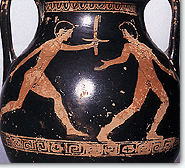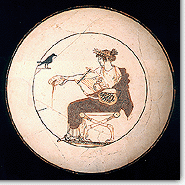


  | |
|
|
The decisive importance of fire in human civilization explains the fascination that it exercised, and its close connection to devotional rituals. Sacrifices without fire were rare, special occasions. However, even the simple existence of fire is interwoven with a certain sanctity. The place where the fire is burning in every house, the hearth (Hestia), is identified with a deity. In many sanctuaries fire always burnt on the altar, the most common being those of Apollo (in Delphi, Argos, Cyrene). In other sanctuaries, instead of fire, an ever burning lamp existed (Athena Polias, Heraion of Argos) and in some cases, as in Athens, a permanent fire was maintained in Prytaneion. In the theology of the Greeks the gods were satisfied by the knissa (the smell and smoke) of the burning bones in sacrifices. But for the further satisfaction of their smell, they also burnt aromatic plants and branches. From the end of the 8th century they started to import aromatic substances from the Phoenicians; for example, incense and unction, whereas at the same time special vessels, the thymiateria, became common for their burning. It is worth noting that the word thyein, which eventually came to mean "to sacrifice" (thysiazo), initially meant fumigations (thymiama). Nevertheless, sacrifice through fire was more related to the dead and the chthonic deities, since burning was one way of burial. Finally, fire acquired a special meaning in certain rituals such as the torchrace from the temenos (temple) of Academus to Acropolis during the Panathenaea, the lighting of the altar in Olympia by the winner of the stadium game and more importantly the procession with torches in various Dionysian festivals. |  |
 | After the battle of Plateae the Greek cities received new fire from Delphi. The extinguishing and rekindling form a characteristic, symbolic representation of the process of purification, of a new beginning and of a reaffirmation of common principals. However for the rituals of purification water was more usual. Purity is in fact one of the elements that define the community and purification the way for the "unclean" to be reincorporated in it, or for the miasma to be sent away. Nevertheless, we cannot eliminate the possibility that purification was some primitive form of decontamination, since it was combined at times with sulphur and other times with fumigation or with washing. Of course the greatest miasma of all was human blood, especially, when it was shed in violation sacred bonds (family) and sacred places (temples, altars). In such cases the unclean person was expelled from the city or he was enforced to do special acts of purification. Apollo was par excellance the god of purifications and his priests who were professed in them were called kathartai. The most celebrated of all was Epimenides the Cretan who came to Athens to release it from the Cyloneion agos, (curse) and among the measures that he took then was the banishment of the family of Alcmaeonidae. |
|
| |
|
Note: Click on picture for short description. | |